g.fast
AT&T Moves Aggressively on G.fast & Expansion of its Fiber Network
AT&T Expands G.fast & FTTH Deployments:
In sharp contrast to Verizon’s decision NOT to deploy G.fast, AT&T has announced expansion of its G.fast service for multi-dwelling units (MDUs) and its fiber-to-the-home network (AT&T Fiber).
The mega telco will extend its all-fiber network in two markets — Biloxi-Gulfport, MS and Savannah, GA. AT&T will also be offering its hybrid fiber-coax service for MDUs in 22 metropolitan markets.
The AT&T G.fast deployments will use “fiber runs to the telecom closet on the property, and individual coax runs to each apartment unit,” an anonymous AT&T spokesperson said to Telecompetitor.
Residents of properties served will also be able to obtain DIRECTV service without installing a dish at their individual units. Instead, the video service will be delivered over D2 Advantage, which the AT&T spokesperson described as “a centrally wired satellite dish that is shared among residents in the property.”
AT&T announced eight metro areas where G.fast can be deployed immediately, including Boston, Denver, Minneapolis, New York City, Philadelphia, Phoenix, Seattle and Tampa. In 14 other markets, consumers in target MDUs can order service now for deployment in “the near future,” the company said.
AT&T is one of multiple carriers that are looking at G.fast as part of their broadband strategy. The technology can support considerably higher speeds than DSL or fiber-to-the-neighborhood (FTTN) services – and although bandwidth is lower than it might be for a fiber-to-the-home deployment, the cost is considerably less.
The news that AT&T is deploying G.fast is not surprising, as the company already has conducted a trial of the service in Minneapolis and executives have indicated deployment plans. At this year’s Open Network Summit (ONS), AT&T’s Tom Anschutz told an audience that G.fast would improve the speed and signal quality of data transmission on older, low grade twisted pair, which is used in many MDUs and in condominium complexes (where this author lives). He hinted that market segment would be a focus area for AT&T.
…………………………………………………………………………………………
AT&T is extending the reach of its fiber network:
AT&T claims to have the largest fiber network in its 21-state home broadband footprint, reaching more than 5.5 million residential and commercial locations across the 57 markets after adding over 1.5 million sites since January 1st. Plans call for extending service availability to another 1.5 million locations by year’s end, boosting the total to 7 million.
Of those 5.5 million homes and businesses now reached by AT&T Fiber, the mega telco said it has signed up more than 2 million broadband subscribers. The company did not, however, break out how many of those subs are new ones, as opposed to DSL customers who have been upgraded to the new FTTH network.
AT&T is the US’s third-largest broadband provider after Comcast Corp and Charter Communications Inc with nearly 15.7 million subscribers at the end of June, 2017.
However, the mega telco ranks #1 on Vertical Systems U.S. Fiber Lit Buildings (Fiber to commercial buildings) leaderboard:

References:
http://about.att.com/story/att_g_fast_on_sale_now_to_apartment_and_condominium_properties.html
https://techblog.comsoc.org/2017/08/16/verizon-passes-on-g-fast-in-favor-of-fttp-for-mdus/
AT&T Moves Aggressively on G.fast & Expansion of its Fiber Network
AT&T Expands G.fast & FTTH Deployments:
In sharp contrast to Verizon’s decision NOT to deploy G.fast, AT&T has announced expansion of its G.fast service for multi-dwelling units (MDUs) and its fiber-to-the-home network (AT&T Fiber).
The mega telco will extend its all-fiber network in two markets — Biloxi-Gulfport, MS and Savannah, GA. AT&T will also be offering its hybrid fiber-coax service for MDUs in 22 metropolitan markets.
The AT&T G.fast deployments will use “fiber runs to the telecom closet on the property, and individual coax runs to each apartment unit,” an anonymous AT&T spokesperson said to Telecompetitor.
Residents of properties served will also be able to obtain DIRECTV service without installing a dish at their individual units. Instead, the video service will be delivered over D2 Advantage, which the AT&T spokesperson described as “a centrally wired satellite dish that is shared among residents in the property.”
AT&T announced eight metro areas where G.fast can be deployed immediately, including Boston, Denver, Minneapolis, New York City, Philadelphia, Phoenix, Seattle and Tampa. In 14 other markets, consumers in target MDUs can order service now for deployment in “the near future,” the company said.
AT&T is one of multiple carriers that are looking at G.fast as part of their broadband strategy. The technology can support considerably higher speeds than DSL or fiber-to-the-neighborhood (FTTN) services – and although bandwidth is lower than it might be for a fiber-to-the-home deployment, the cost is considerably less.
The news that AT&T is deploying G.fast is not surprising, as the company already has conducted a trial of the service in Minneapolis and executives have indicated deployment plans. At this year’s Open Network Summit (ONS), AT&T’s Tom Anschutz told an audience that G.fast would improve the speed and signal quality of data transmission on older, low grade twisted pair, which is used in many MDUs and in condominium complexes (where this author lives). He hinted that market segment would be a focus area for AT&T.
…………………………………………………………………………………………
AT&T is extending the reach of its fiber network:
AT&T claims to have the largest fiber network in its 21-state home broadband footprint, reaching more than 5.5 million residential and commercial locations across the 57 markets after adding over 1.5 million sites since January 1st. Plans call for extending service availability to another 1.5 million locations by year’s end, boosting the total to 7 million.
Of those 5.5 million homes and businesses now reached by AT&T Fiber, the mega telco said it has signed up more than 2 million broadband subscribers. The company did not, however, break out how many of those subs are new ones, as opposed to DSL customers who have been upgraded to the new FTTH network.
AT&T is the US’s third-largest broadband provider after Comcast Corp and Charter Communications Inc with nearly 15.7 million subscribers at the end of June, 2017.
However, the mega telco ranks #1 on Vertical Systems U.S. Fiber Lit Buildings (Fiber to commercial buildings) leaderboard:

References:
http://about.att.com/story/att_g_fast_on_sale_now_to_apartment_and_condominium_properties.html
https://techblog.comsoc.org/2017/08/16/verizon-passes-on-g-fast-in-favor-of-fttp-for-mdus/
Verizon passes on G.fast in favor of FTTP for MDUs
Verizon will forgo using copper-based G.fast (DSL) technology in favor of an all-out move to deploy fiber-to-the-premises (FTTP) to/from multiple-dwelling units (MDUs), according to Vincent O’Byrne, director of network planning for Verizon. Mr O’Byrne spoke August 15th at ADTRAN’s Broadband Solutions Summit in Huntsville, AL.
“Our strategy for G.Fast is not to deploy it,” O’Byrne said at the conference.
“The strategy we’re using today is fiber all the way to the living unit,” O’Byrne said. “There’s some small percentage that we use fiber to the building (FTTP) and then copper inside the building itself, but because we have two vendors on BPON and on GPON meant in those units we had 8 types of different MDU units.”
O’Byrne cited the sketchy nature of the copper network in some places and a history of VDSL2 inter-operability and speed related problems in MDUs.
“The MDU units started to go end of life and for VDSL2 there wasn’t any interoperability,” O’Byrne said. “Even though we worked on it for a year, it became nuisance so we stopped using those common ONTs and concentrated on getting fiber to the living unit.”
Speed is also an issue. “We ended up in a situation where the 13 units of VDSL2 were going end of life as well as lower speed down the surrounding Fios network, which could get up to 1 Gbps,” O’Byrne said. “With G.fast we see ourselves potentially being in the same situation five years from now where we would have to replace the same thing.”
O’Byrne said that bringing fiber directly to each premises is more of a future proof strategy. “It’s a bit more expensive to put the single family unit fiber connections out there, but we have the same kind of service as the rest of the network,” O’Byrne said. “We also found that the trouble report rate is less on the fiber all the way to the living unit.” That’s in sharp contrast to the hybrid fiber-copper technology used by AT&T in its U-Verse triple play bundle (which this author has had for almost 5 years).
Given the diversity and varying condition of copper plant in Verizon’s wider nationwide network, Verizon has applied its copper replacement strategy for the MDU markets.
In recent years, Verizon has been strategically replacing aging copper plant with fiber at its consumer and business locations. The service provider said that this method enables it to reduce costs by not having to perform multiple customer visits when problems arise.
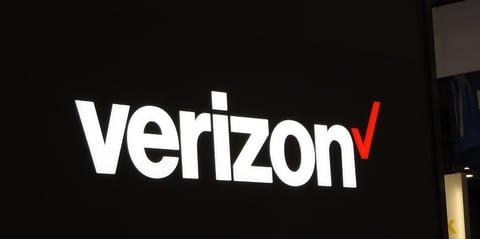
Verizon has been replacing aging copper plant with fiber at its consumer and business locations. Fios to residential triple play customers was the first step, with fiber to commercial buildings and MDUs now well underway.
“At Verizon we were finding the trouble reports on the copper were two to three times more than when we had fiber to the living unit,” O’Byrne said. “For a long time, the copper plant in the Verizon network was not as good as it was in some locations so if we went to G.fast it would be low volume and we would have the same issues five years down the road.”
“We’re skipping XGS-PON single wavelength,” said O’Byrne. “We’re going for a 10G tunable laser solution.”
O’Byrne said driving costs lower and providing a unified architecture that’s inter-operable across multiple equipment vendors are key goals for their strategy. He also mentioned solutions that can maximize use of Verizon’s extensive and somewhat disparate outside wiring plant environment.
References:
Combined FTTH and DSL spending set to slow until 10 Gbps PON and G.fast deployments
By Jeff Heynen of SNL Kagan
After a record year in which total estimated revenue for combined digital subscriber line, or DSL, and fiber-to-the-home, or FTTH, network infrastructure reached $9.77 billion worldwide, 2017-2019 should produce a slowdown in spending. Kagan, a media research group within S&P Global Market Intelligence, is forecasting a trough being driven by expected slowdowns in 1G EPON and 2.5G gigabit passive optical networks (GPON) spending as operators wait for 10Gig technologies, including XGS-PON to become more widely available. Equipment revenue is expected to drop to $9.43 billion in 2017, $8.98 billion in 2018 and $8.80 billion in 2019, as optical line terminal, or OLT, purchases for network expansion slow and prices for current-generation technologies continue to decline.
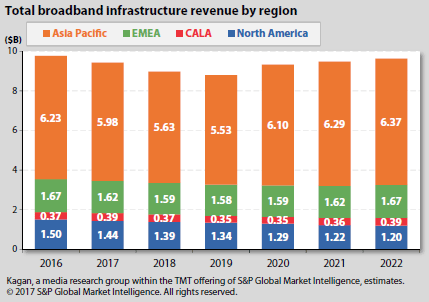
The vast majority of revenue will continue to come from the APAC region, specifically China, where China Telecom Corp. Ltd., China Unicom and China Mobile benefit from favorable regulatory policies designed to reduce FTTH construction and installation costs to help achieve national penetration and average bandwidth per user goals. Of the 95 million FTTH optical network termination, or ONT, units shipped in 2016 throughout the APAC region, we estimate that 83.5 (80.1 million) shipped to China. We expect total ONT shipments to the main Chinese operators will continue to stay in the 75 million to 80 million range through 2020, as the operators look to replace aging units with more integrated gateway units.
North American FTTH equipment spending was up 30% in 2016, surpassing $1.12 billion in equipment revenue, a first for the region and an indisputable challenge to the assertion that broadband spending in the region has declined. Total spending in North America was driven by 2.5G GPON equipment purchases at Verizon Communications Inc., AT&T Inc., Alphabet Inc.‘s Google Fiber and a growing number of tier 3 operators. Demand for new equipment is being driven primarily by Verizon, which is adding new FiOS subscribers and updating older GPON ONT models, and AT&T, which continues to expand its GPON-based AT&T Fiber footprint. But other operators, including CenturyLink Inc., Windstream Holdings Inc., Frontier Communications Corp. and Telephone and Data Systems Inc., continue to transition a growing percentage of their network footprint to fiber. However, we do believe that some of these initiatives, particularly Verizon’s FiOS upgrades, will slow after the peak in 2016, pushing revenue down to $1.07 billion in 2017 and $999.4 million in 2018.
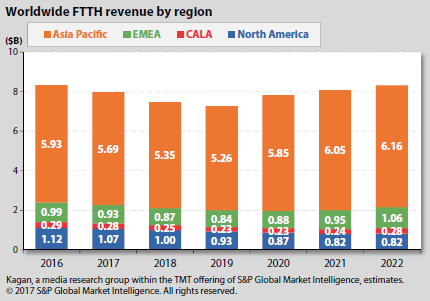
2.5G GPON remains the workhorse FTTH technology on a global basis, with operators including Verizon, AT&T, China Telecom, China Mobile, China Unicom, Telefónica S.A. and many others relying on the technology for their residential FTTH deployments. We expect 2.5G GPON will remain the leading technology choice through 2021, as ONT shipments to support subscriber growth on existing networks remain high, despite the increased rollouts of XGS-PON and NG-PON2 technologies over time.
Saturation, waiting on 10G, and a focus on 5G will keep revenue growth in check
Though 2016 was a strong year for FTTH equipment revenue, it is likely to be the peak throughout our forecast period. In 2017, revenue is expected to decline from $8.33 billion to just under $8 billion. Chinese operators are expected to slightly slow their OLT rollouts after seven straight years of phenomenal growth. Their focus will be less on new FTTH network expansion and more on continued subscriber acquisition, which will result in continued spending on ONT units. Also, the three main Chinese operators will be rolling out 10G EPON and 10G GPON equipment, as they wait on XGS-PON equipment availability. The focus will be on improving bandwidth in major metropolitan areas, especially among subscribers currently served by fiber-to-the-building (FTTB) + local area network (LAN) architectures, which typically max out at 10 Mbps downstream.
In North America and Western Europe, FTTH network buildouts, measured in the number of new OLT ports shipped, will slow after 2018, when a combination of factors are expected to reduce overall investment levels:
* Many operators will have reached saturation levels within their core FTTH networks. Like Verizon, these operators will hold off on additional territory expansions and instead focus on securing subscribers within their existing serving areas. The net result will be declining OLT shipments and sustained ONT unit shipments.
* Operators will wait until 10G variants of PON technologies become more widely available and therefore less expensive, particularly 10G EPON for cable operators, XGS-PON, which delivers symmetric 10 Gbps of throughput and NGPON-2, which delivers up to 40 Gbps of symmetric throughput.
* Finally, operators will begin shifting their spending toward preparing for upcoming 5G wireless networks. The early stages of 5G network buildouts will focus on metro areas and will rely on existing fiber connections for backhaul purposes.
Beginning in 2020, overall spending on FTTH equipment is expected to pick back up, based on increased shipments of 10G EPON, XGS-PON and NGPON-2 equipment to support upgrades to first-generation FTTH networks, business services and the backhaul of 5G wireless network traffic. By 2022, we expect total FTTH equipment spending to be $8.32 billion, nearly equal to the 2016 peak.
In a change from our October forecast, we now expect XGS-PON to become the leading next-generation technology during our current forecast period. Previously, we had expected that NGPON-2, driven by anticipated deployments at Verizon, China Telecom, and others would become the leading next-generation technology. However, after conversations with service providers, equipment vendors and component suppliers, we do not see NGPON-2 equipment, with its reliance on expensive, tunable optics, becoming widely deployed for FTTH applications until 2021 and beyond.
In our previous forecast, we expected worldwide revenue for NGPON-2 equipment in 2021 to reach $2.20 billion. We now expect it to reach just over $1 billion in 2021, with much of the revenue coming from Verizon, as it upgrades its FiOS network. By 2021, portions of Verizon’s FiOS network will be over a decade old. And with cable operators’ aggressive deployments of DOCSIS 3.1 technologies, Verizon will be forced to switch to NGPON-2 to provide a bandwidth advantage for the next decade. In addition, Verizon is expected to rely on NGPON-2’s ability to deliver multiple wavelengths to support the backhaul of mobile data traffic from its 5G base stations. A single NGPON-2 OLT can theoretically split multiple wavelengths for residential services, mobile backhaul and business services.
While Verizon is expected to stick with its plan to move to NGPON-2, a larger number of operators around the world will opt for XGS-PON, beginning in late 2017, but picking up steam in 2019. XGS-PON uses fixed optics and wavelengths, like current GPON technologies, but also provides an upgrade path to tunable optics for operators that want to move to NGPON-2 down the road.
Many operators have a 5-year goal of getting symmetric 10 Gbps services out to their customers, which would provide them an edge over cable competitors who will likely be stuck with asymmetric services through at least 2020, when full duplex DOCSIS 3.1 equipment becomes available. XGS-PON gives them the ability to deliver symmetric 10 Gbps services at price levels that are currently 4x 2.5G GPON equipment prices, as opposed to the minimum 10x 2.5G GPON costs currently seen for NGPON-2 equipment. FTTH is an expensive proposition as-is, with labor and operational costs generally consuming 70% of the budget. Equipment costs have to be controlled in order to ensure reasonable payback periods for network operators. Right now and for at least the next two years, NGPON-2 equipment will simply be too much cost to bear for most operators. Hence, the growing interest in XGS-PON among operators including AT&T, China Telecom and a growing list of tier 2 and tier 3 operators globally.
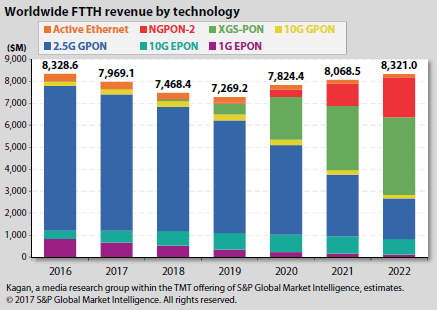
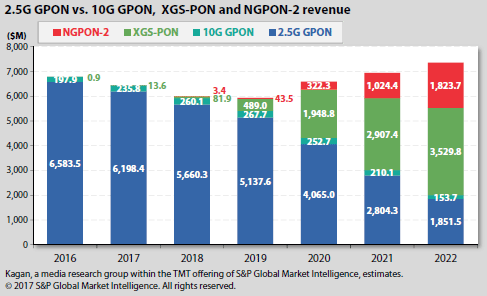
For operators with 1G EPON-based deployments — particularly Korea Telecom, Japan‘s NTT DOCOMO access, China Telecom and China Unicom, 10G EPON is quickly becoming the next-generation technology of choice for providing both asymmetric and symmetric 10 Gbps services. 10G EPON equipment shipments and revenue continue to grow, driven currently by China Telecom, which is in the process of upgrading a portion of its first-generation 1G networks to provide more bandwidth to multi-dwelling units, or MDUs.
Longer-term, cable operators in North America and Western Europe will deploy 10G EPON in Greenfield deployments and, on occasion, in overbuild situations, as well as for business services. Of course, MSOs will rely heavily on DOCSIS 3.1 for the bulk of their residential deployments. But 10G EPON will also be an important technology for cable operators for MDU deployments and business services, particularly as fiber is pushed deeper into the network and remote nodes are converted into OLTs.
Our equipment revenue forecasts for 10G EPON have been nearly doubled, due largely to higher-than-expected spending levels seen in 2016 in China, but also due to our expectations that a growing number of cable operators will mix in a higher percentage of 10G EPON for greenfield FTTH buildouts. Altice USA, Inc. has already committed to a full FTTH network buildout across its footprint, which we have now factored into our forecasts. In addition, we expect other North American MSOs to slowly migrate to 10G EPON for both their business and greenfield residential access networks.
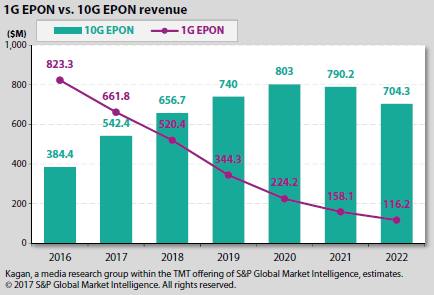
VDSL and G.fast spending to sustain DSL infrastructure market through 2019
Global spending on DSL equipment by operators and ISPs is expected to increase by 1.4% this year, with 2017 equipment revenue now expected to rise to $1.46 billion. The primary reason for the increase is a resumption in spending in the CALA region, which saw 2016 equipment revenue plummet to $75.8 million. Economic uncertainty in the region, as well as a decision by Telmex to halt its VDSL rollouts helped to push revenue down sharply in the region. We now expect DSL spending to reach normal annual levels, with 2017 revenue to reach $117.5 million.
Outside of CALA, declines are once again expected this year in North America, where total DSL revenue is expected to drop from $388.3 million in 2016 to $368.9 million in 2017. AT&T’s continued shift for its U-Verse service from very high bit rate digital subscriber line generation 2 (VDSL2) GPON is expected to result in a decline of another 600,000 VDSL ports from 2016 to 2017.
EMEA remains the world’s largest market for DSL infrastructure: 47.2% of global revenue comes from this region, where incumbents such as British Telecom (BT), Deutsche Telekom AG (DT), Orange SA, Telefonica and others continue to rely on asymmetric digital subscriber line (ADSL) and VDSL technologies for the bulk of their residential broadband service offerings. Providers have shifted a small percentage of their broadband networks to FTTH and will continue to do so. However, the cost of widespread fiber deployments, as well as line-sharing obligations will keep the bulk of broadband connections in this region copper-based. Throughout our forecast, the EMEA region will constitute 46% to 48% of global DSL revenue and will continue to be the leading region for G.fast deployments.
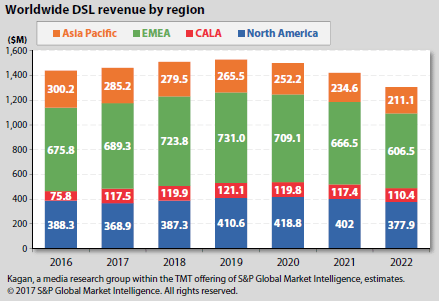
Along with the revenue increase expected in 2017, total DSL ports should also increase from 54.8 million in 2016 to 58.3 million. Further increases in total ports are expected through 2020, as service providers continue to shift away from ADSL/ADSL2+ technologies to VDSL2, VDSL Profile 35b and G.fast. From 2021 forward, however, we do expect the total market for DSL ports will decline, as more operators switch to FTTH as a logical progression from their deep fiber deployments to support VDSL2 and G.fast deployments.
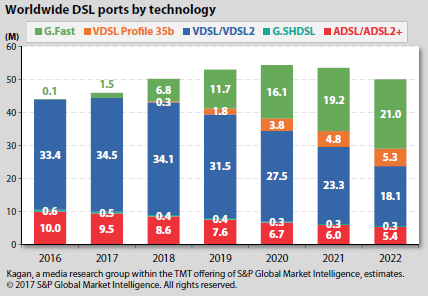
G.fast, a high-frequency DSL protocol designed for copper loops of 250 meters that can deliver between 150 Mbps and 1Gbps, will be relied upon by BT, Orange, Telekom Austria Group, AT&T and others in the coming years. CenturyLink already announced a 44-building G.fast deployment in Platteville, Wis. CenturyLink is expected to continue its G.fast deployments throughout 2017 and beyond. But BT is expected to drive the most G.fast port and customer premises equipment (CPE) shipments, with its announced plan to pass 10 million homes with G.fast by 2020.
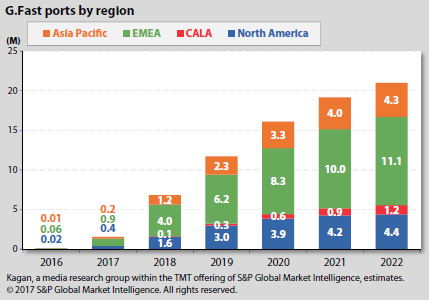
Until G.fast silicon chips, infrastructure and compatible CPE products are available in volume, VDSL2 will remain the workhorse technology. Vectored VDSL2 can provide 100 Mbps to 150 Mbps service over copper loops of 500 meters and has been used by a large number of operators in North America, EMEA and CALA to remain competitive with fiber over builders and cable operators.
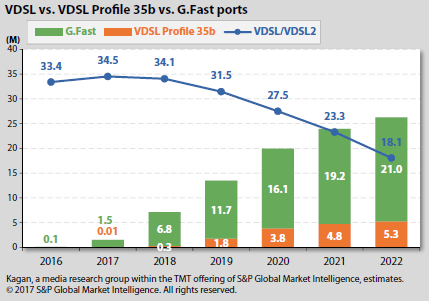
VDSL profile 35b, alternately called Super VDSL or Vplus, provides a niche solution between vectored VDSL2 and G.fast. At loop lengths between 250 and 500 meters, VDSL profile 35b can provide speeds ranging from 200 Mbps to 300 Mbps. Germany‘s DT is the leading proponent of this technology, as the operator has yet to deploy a significant amount of vectored VDSL2 and can therefore more cost-effectively make the transition to the 30 MHz vectoring of profile 35b. Additionally, DT has a large percentage of copper lengths within the 250 to 500 meter range, making it the ideal target for this technology.
Reference:


